Businesses need to stay flexible and ready for change. That’s where virtual phone systems come in. They make it easier for teams to talk, work together, and stay connected from anywhere. No matter the size of your business, a virtual phone system can help you work better and faster.
Thinking about switching to a virtual phone system? It might be the right move for your business.
Join us as we explore the world of virtual phone systems, top providers, their key components, top features, benefits, and how to choose the right one for your business.
Key Takeaways
- Virtual phone systems provide businesses with flexibility, cost-effectiveness, and automation capabilities.
- Features such as IVR, call recording & team collaboration tools enable streamlined communication processes & improved productivity.
- Choose the right virtual phone system by looking at the features, pricing, and how well it can grow with your business. This helps you keep communication smooth and simple as your team and needs change.
Understanding Virtual Phone Systems
Traditional landlines are no longer the go-to option. These days, virtual phone systems are what most businesses use. They work through the internet and cloud services, so there’s no need for old-school phone lines.
This makes things easier, cheaper, and much more flexible. Switching from a landline to a cell phone is also a lot smoother now.
Virtual phone systems are made to work with what you already have. They support your current numbers, including toll-free ones.
These systems work using the Internet Protocol, or IP. That means they send calls and messages over the internet instead of using wires, like old business phones.
You can use them on your phone, computer, or laptop. This means you can stay connected no matter where you are, which helps teams that work from different places.
Cost matters, and virtual phone systems help you save. Prices usually range from $17 to $80 per user per month. Talkroute makes it even more affordable. We offer flat-rate plans, and adding a new user only costs $5 per month.
As more businesses start using virtual phone systems, it’s good to know what makes them work so well.
8 Top Virtual Phone System Providers in 2025
In 2025, several providers stand out as the best virtual phone system options, each offering distinct features for varying business requirements.
1. Talkroute

Talkroute is a business phone system that helps you talk, text, and meet with customers from anywhere. You can forward calls to any phone, set up custom call paths, and manage your team’s extensions with ease.
It works with your desktop, laptop, and mobile devices, so you don’t need to buy special hardware. Everything runs through simple apps, making it easy for your team to stay connected whether they’re at the office or on the move.
With Talkroute, you also get business texting, video meetings, voicemail management, and call recording in one place. You can create menus to guide callers, set schedules for when your phones ring, and review calls for training or support.
Key Features
- Call forwarding and routing – Send calls to any phone or desktop anywhere in the world, including mobile, landline, or even satellite phones.
- Route calls to desktop apps – Direct calls to your team’s laptops or desktops using apps for Mac, Windows, and Linux.
- Custom ring strategies – Choose to ring phones in a set order or all at once. Add custom hold music or messages.
- Scheduled call routing – Pick the exact times and days you want your phones and computers to ring.
- Custom call paths – Set up different routing options for each menu, number, or extension in your system.
- Business texting – Send and receive SMS from your business numbers, including local and toll-free numbers.
- Text message management – Use Talkroute apps or your browser to manage and reply to messages quickly.
- Text-to-email alerts – Get email alerts with message details whenever someone texts your business number.
- Text message permissions – Control who on your team can see, read, or reply to text messages.
- Video meetings – Host or join video calls with up to 100 participants from any device.
- Team chat in meetings – Use built-in chat during meetings to talk with your team.
- Screen sharing – Show your screen during video meetings to present, teach, or help others.
Make and receive VoIP calls from any device. Start your free Talkroute trial.
2. RingCentral
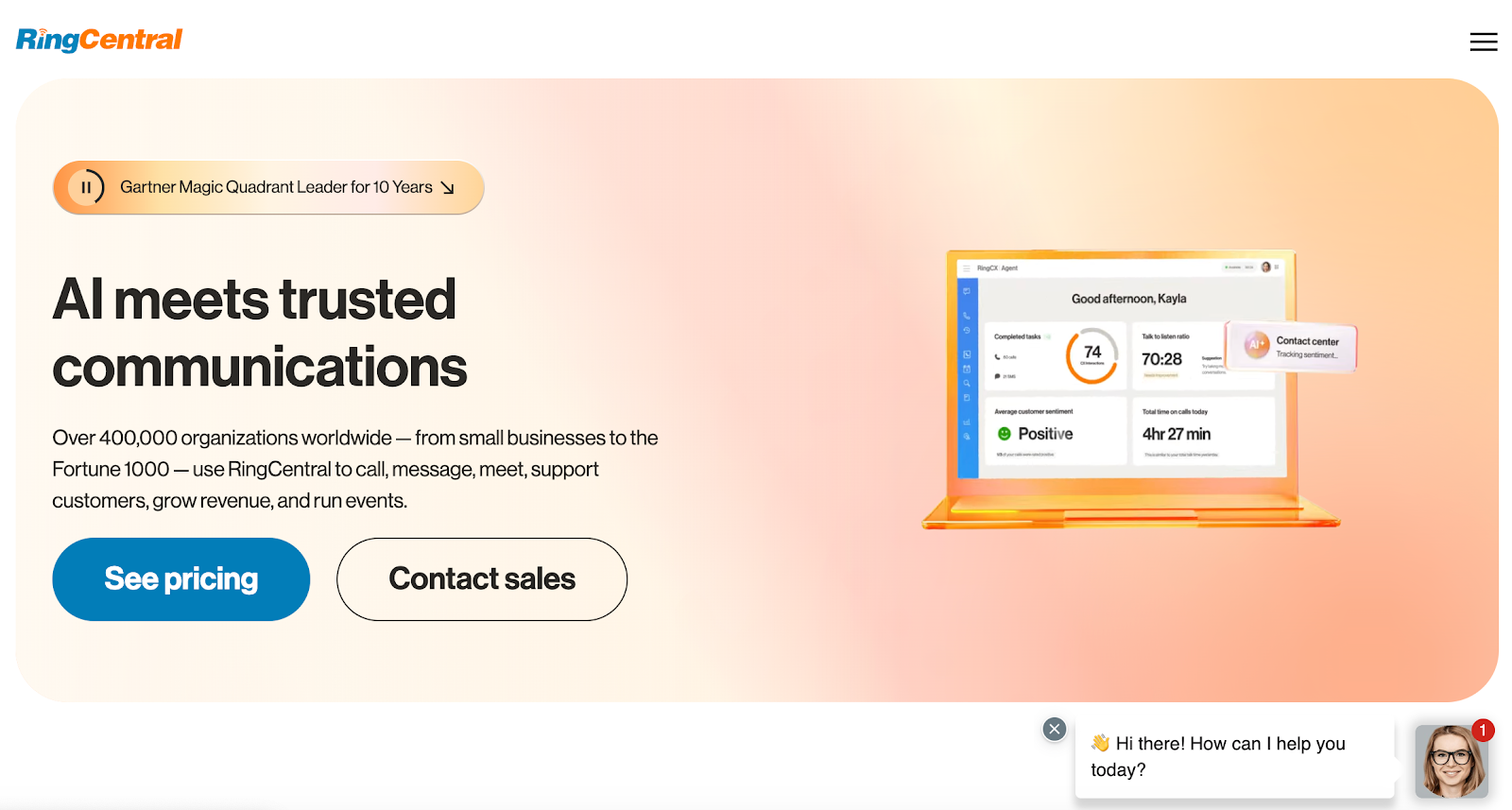
Source: ringcentral.com
RingCentral is a business communication platform that offers calling, messaging, video meetings, and contact center solutions. It supports teams of all sizes, from startups to large global companies, with tools that help employees stay connected across devices.
Businesses in different industries use RingCentral to manage internal communication and customer interactions.
Key Features
- Business calling and messaging – Make calls and send messages from one app
- Video meetings – Host HD video calls with screen sharing
- AI summaries – Get automated notes after calls
- Contact center support – Manage customer interactions in one place
- App integrations – Connect with over 300 business tools
Recommended reading
RingCentral vs Grasshopper: Which One Is Good For You?
3. 8×8
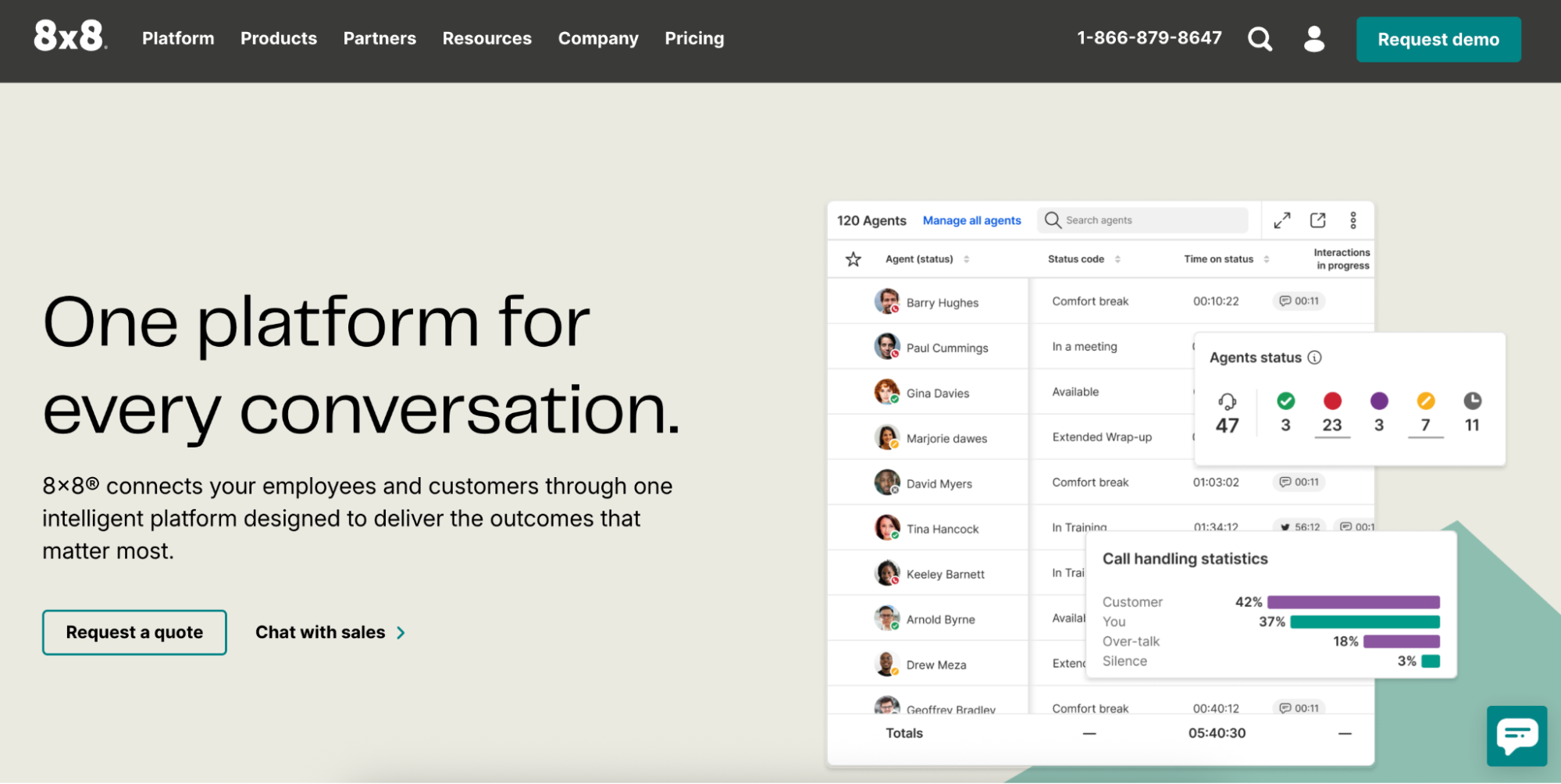
Source: 8×8.com
8×8 is a communication platform that combines voice, messaging, video, and customer engagement tools in one system.
It supports global businesses with built-in security, integrations, and features designed to help teams work together and connect with customers across multiple channels.
Key Features
- Voice and video communication – Offers phone calls and HD video meetings from any device
- Messaging across channels – Supports SMS, WhatsApp, and other major platforms
- Contact center tools – Includes features for customer support and engagement
- Global availability – Provides service and support across multiple countries
- Built-in security and compliance – Meets various industry standards and certifications
4. Dialpad
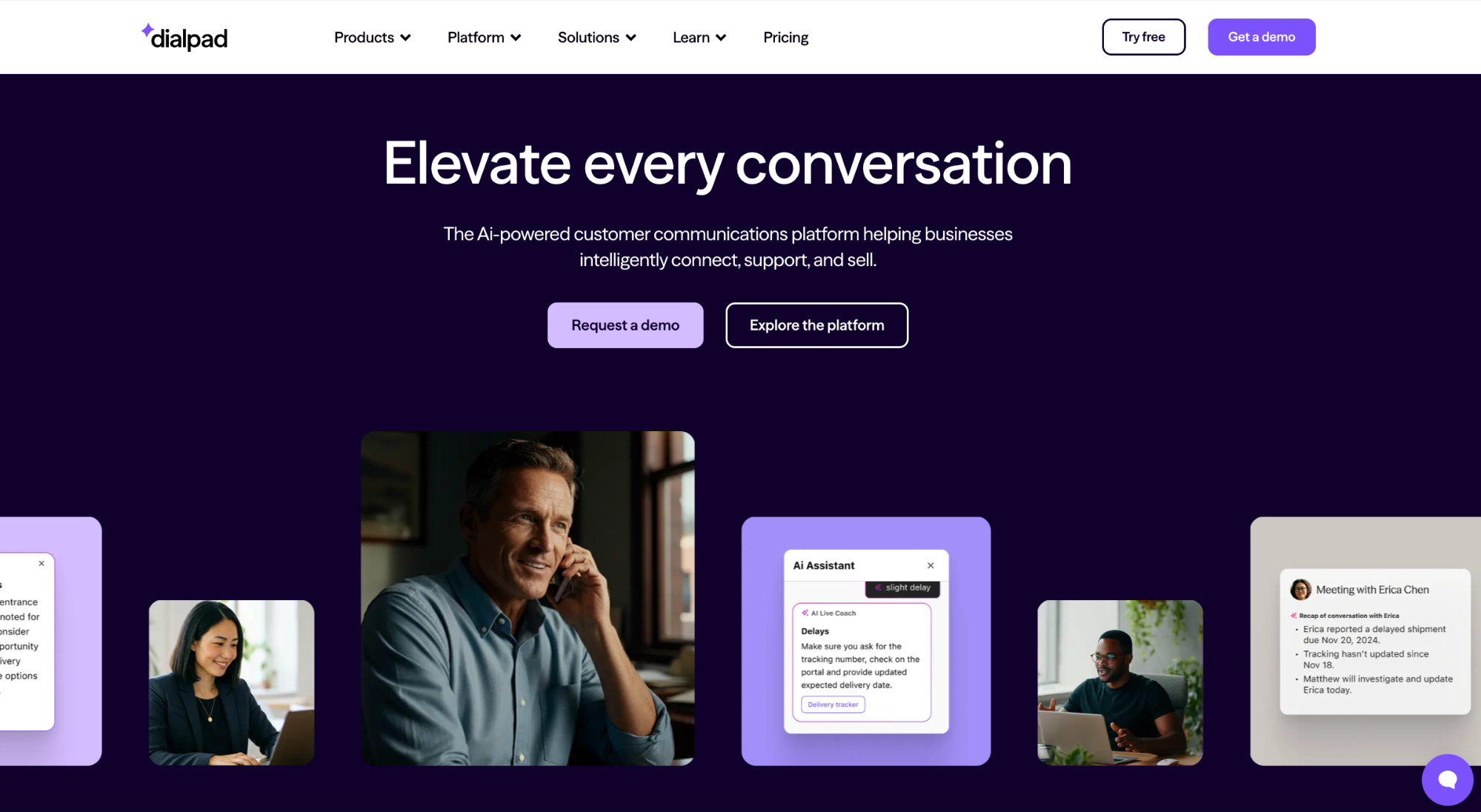
Source: dialpad.com
Dialpad is a business communication platform that combines phone calls, video meetings, messaging, and AI-powered tools. It’s designed to support customer service, sales, and team collaboration.
With built-in artificial intelligence, Dialpad offers features like real-time call coaching, meeting summaries, and customer sentiment analysis.
Key Features
- AI call summaries – Automatically creates notes and highlights from meetings and calls
- Live agent coaching – Provides real-time tips during customer calls
- Voice, video, and messaging – Combines all communication methods in one platform
- CRM and app integrations – Connects with Salesforce, Microsoft, Google, and more
- AI-powered analytics – Tracks performance, call sentiment, and customer satisfaction
Recommended reading
Ring Central vs Dialpad: Which Fits Your Needs Best?
5. Grasshopper
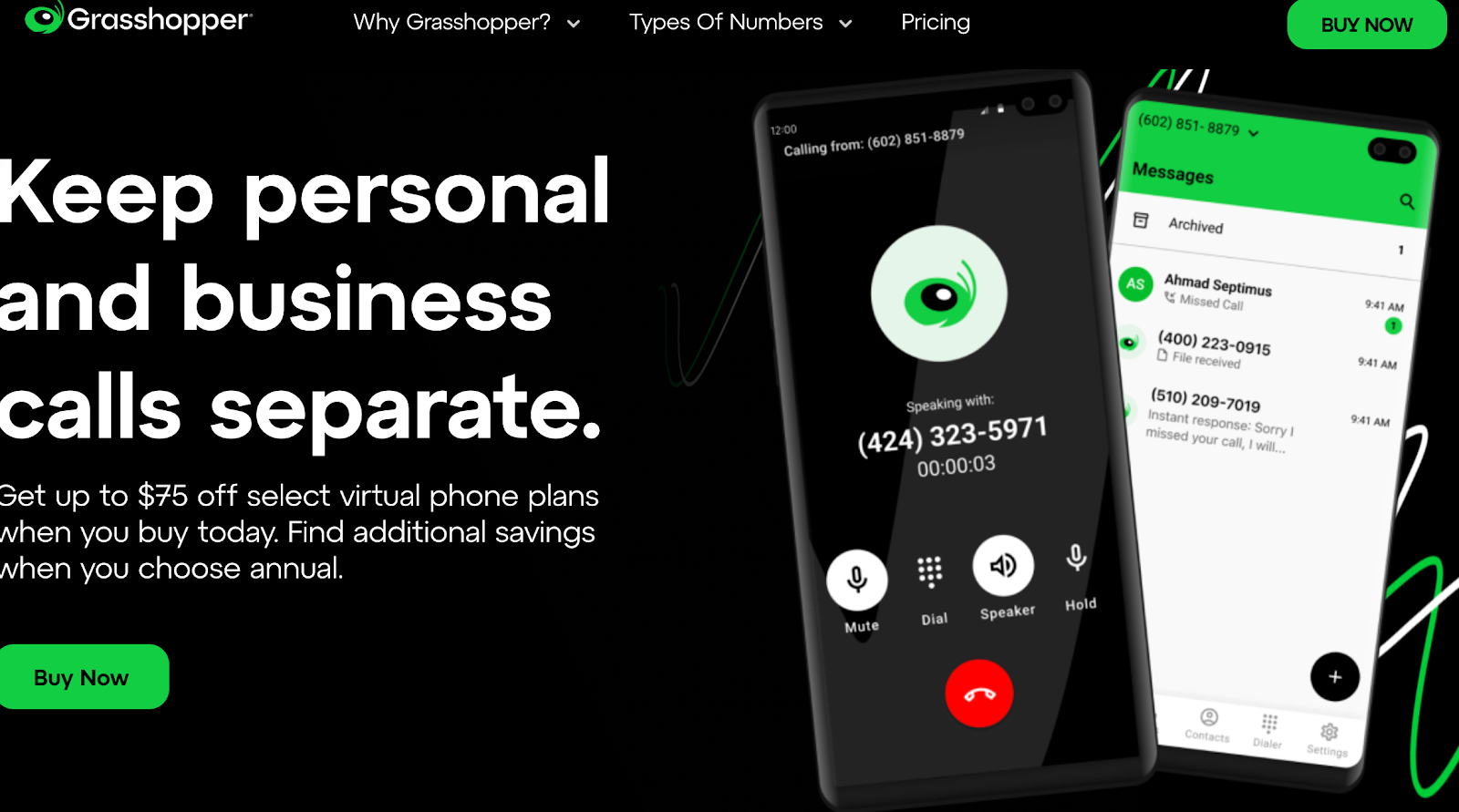
Source: grasshopper.com
Grasshopper is a virtual phone system built for small businesses and solo professionals who want to separate business and personal calls. It works through mobile and desktop apps, so there’s no need for extra hardware.
Users can pick a toll-free, vanity, or local number, or port an existing number into the system. Grasshopper supports calling, texting, voicemail, and other standard phone features, all through one easy-to-use platform.
Key Features
- Business numbers – Choose from toll-free, vanity, or local numbers
- Mobile and desktop apps – Call and text from smartphones or computers
- Voicemail transcription – Read voice messages instead of listening
- Call forwarding – Route calls to your personal number
- Business texting – Send and receive messages from your business number
6. Vonage
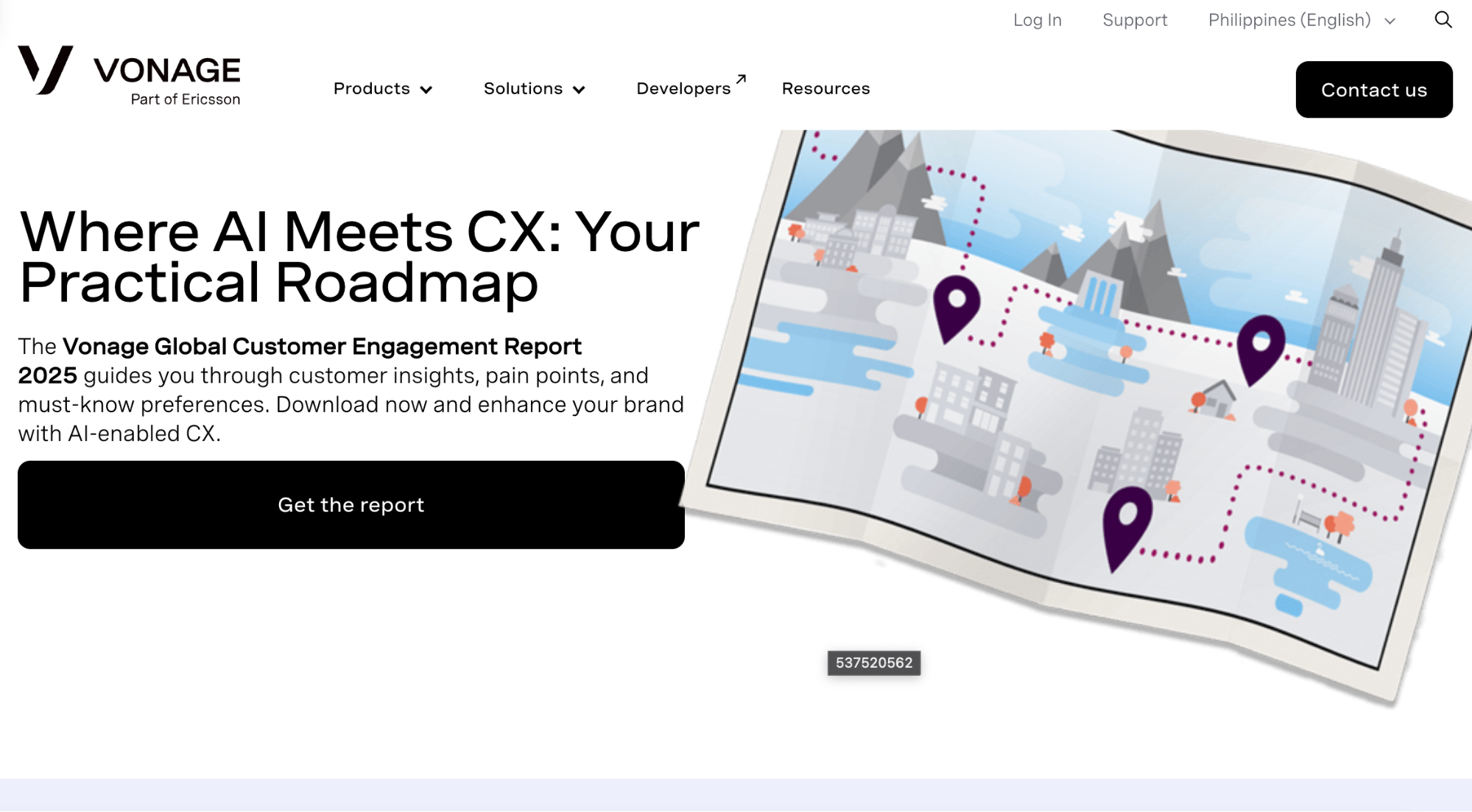
Source: vonage.com
Vonage is a cloud-based communications provider that offers voice, messaging, video, and contact center services for businesses.
Its platform is built to support customer engagement, team collaboration, and app development through a mix of unified communications, communications APIs, and AI features.
The platform includes tools for building custom customer experiences, such as integrating voice or messaging into apps or setting up AI-assisted contact centers.
Key Features
- Unified communications – Combines phone, messaging, and video in one system
- Communications APIs – Add voice, messaging, and video features into apps
- AI-powered contact centers – Support customer service with automation and insights
- Developer tools – Access APIs and network features to build communication apps
- Global reliability – Offers 99.999% uptime with service available in many countries
7. OpenPhone
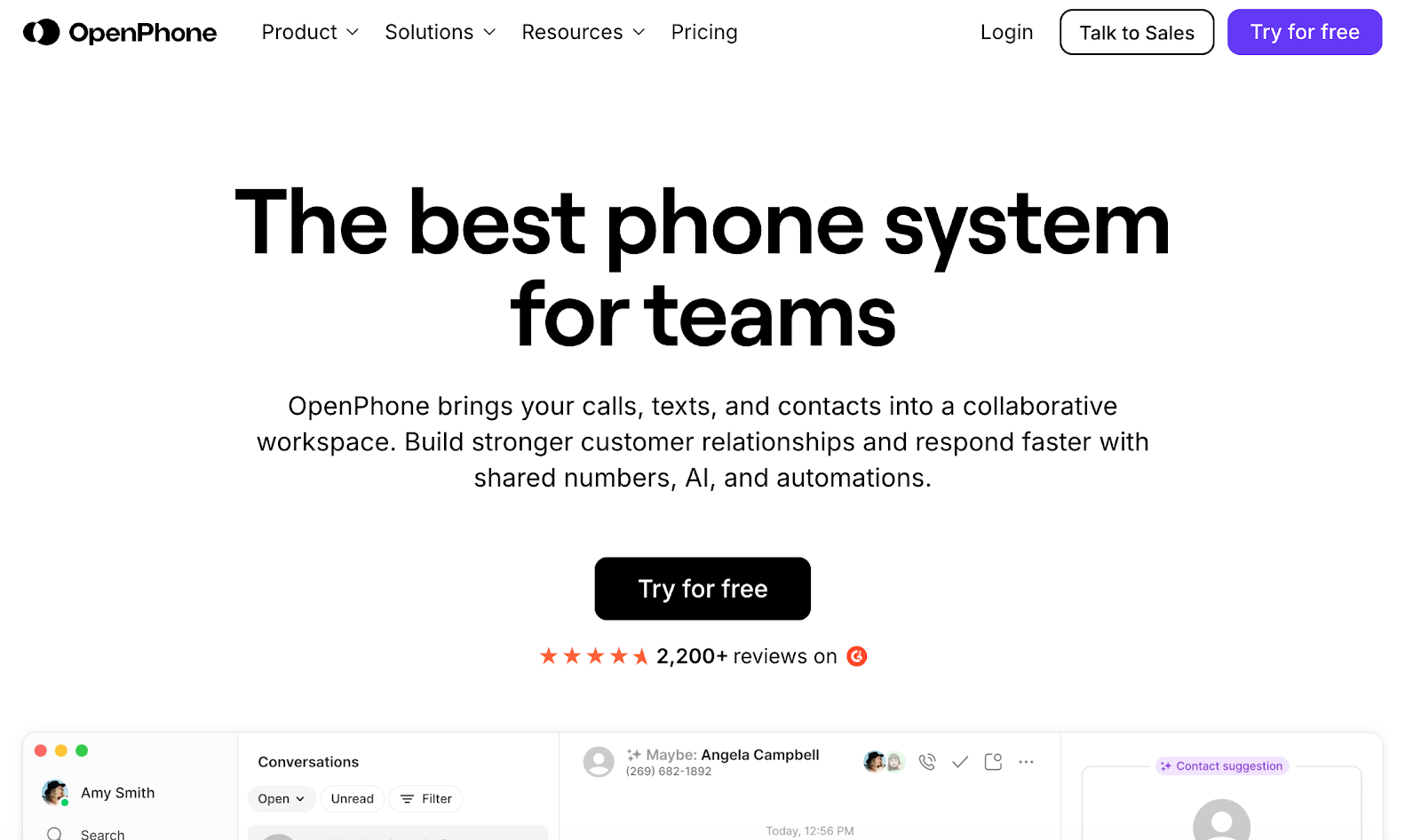
Source: openphone.com
OpenPhone is a virtual phone system that helps teams manage calls, messages, and contact details in one shared workspace.
It’s designed for businesses that want a simple and flexible way to communicate with customers using local or toll-free numbers. OpenPhone works on desktop and mobile devices, so teams can stay connected from anywhere.
The platform includes tools for call handling, text messaging, and voicemail, along with built-in AI features like automatic call summaries and transcripts.
Key Features
- Shared inbox – View calls, texts, and voicemails in a single conversation thread
- AI call summaries and transcripts – Save time by reviewing auto-generated notes and transcripts
- Shared numbers and team features – Let teams collaborate on customer calls and messages
- Call routing and menus – Direct calls to the right person with routing and menu options
- App integrations and OpenPhone API – Connect with CRMs and customize workflows
Recommended reading
RingCentral vs OpenPhone: Which One Offers More Value?
8. Aircall

Source: aircall.io
Aircall is a cloud-based phone and communication platform designed for sales and support teams.
It brings together calls, texts, WhatsApp messages, and AI tools into one system. The platform helps businesses improve their customer conversations by offering features like real-time AI insights, automation, and call analytics.
Aircall also supports global calling, shared team inboxes, and integrations with over 100 tools like Salesforce, HubSpot, and Zendesk.
Key Features
- AI Voice Agent – Handles inbound calls automatically, qualifying leads 24/7
- AI Assist – Offers real-time coaching and automates workflows during live calls
- Unified communication hub – Supports calls, SMS, and WhatsApp in one place
- Shared inbox and call recordings – Helps teams stay aligned and onboard new agents
- 100+ integrations – Connects with CRMs and help desk tools for better workflow
Recommended reading
Aircall vs Dialpad: Features, Price, and Which One to Choose
Key Components of a Virtual Phone System

Businesses aiming to tap into the full potential of virtual phone systems must grasp their essential components. These systems are built upon three main pillars: call forwarding, VoIP technology, and cloud-based infrastructure.
The forthcoming subsections will delve into each of these elements, highlighting their role in facilitating smooth communication.
Call Forwarding
Call forwarding lets you send calls to another phone or device, so no call gets missed. It’s a simple feature, but it brings a lot of value to your business.
With call forwarding, your team can take calls whether they’re at their desk or working somewhere else. It helps reduce missed calls and gives customers a better chance of reaching someone right away. That means more calls get answered on the first try.
Talkroute offers a feature called “ring in sequence.” This means you can set calls to go through a list of numbers in a specific order.
If someone doesn’t answer at their desk, the call goes to their mobile phone or another number. On top of that, Talkroute has call filtering. You can block spam calls or route calls based on your own schedule.
For bigger teams or businesses that get a lot of calls, long wait times can be a problem. Call forwarding and smart routing help with that. They spread calls across your team so customers don’t have to wait too long.
You can also set up custom greetings and voice menus to guide callers to the right person or department.
VoIP Technology
Voice over Internet Protocol (VoIP) technology is the driving force behind virtual phone systems, enabling voice communication over the internet. Instead of using old phone lines, companies can now make calls over the internet. This makes things faster and often much cheaper.
One useful part of VoIP is something called SIP trunking. It lets businesses connect their existing phone hardware to VoIP services. If a company has its own IT team and equipment, SIP trunking helps them save money while keeping their setup running smoothly. There’s no need to buy extra hardware.
VoIP also comes with helpful features. A good example is visual voicemail. It turns voice messages into text, so you don’t have to listen to each one.
You also get the audio file if you want to hear it. This makes it easier for staff to sort messages and reply faster. They can check messages through a simple portal, where they can play, save, or delete them.
Cloud-Based Infrastructure
Virtual phone systems run on cloud-based infrastructure, and that’s what makes them so flexible and easy to scale. Instead of needing equipment at your office or hiring IT staff to manage everything, you can use cloud tools to handle your phone system. It’s simpler, more affordable, and still gives you access to advanced features.
One important part of this setup is something called hosted PBX. This just means that a third-party provider runs the system for you, using their own equipment off-site.
This setup allows businesses to focus on their core operations without worrying about software, equipment, updates, or IT issues.
You get a full-featured phone system, but without the hassle. You can focus on your work while the provider handles the tech side.
The cloud-based setup uses a mix of hardware and software to make everything run smoothly. This includes things like:
- Servers and storage – These handle the data and calls
- Networking – This connects everything together
- Virtualization resources – These make it easy to manage different systems through the cloud
All these parts work together to give your business a strong and reliable phone system. Because it’s cloud-based, you can easily adjust as your team grows or changes. You don’t need to buy more hardware or do a big setup. You just scale your plan up or down.
Top Features of Virtual Phone Systems

Virtual phone systems come packed with a variety of features that cater to different business needs. Some of the most notable features include interactive voice response (IVR), call recording, and team meeting tools.
These features not only enhance the functionality but also enable businesses to streamline their communication processes.
Interactive Voice Response (IVR)
IVR usage, for example, allows businesses to set up automated menus and payment systems for callers, guiding them through different options with the help of their phone keypads or voice input.
This feature helps businesses manage incoming calls efficiently and ensures that customers receive the assistance they need without delay.
Call Recording
Call recording is another powerful feature that can benefit businesses in various ways, such as maintaining records for compliance purposes, training employees, and improving customer service.
With virtual phone systems, call recording can be easily enabled, and privacy can be maintained by safeguarding recordings with a password or pausing and resuming the recording at different points during a conversation.
Team Meeting Tools
Team meeting tools offered by virtual phone systems help businesses work more efficiently by providing features such as:
- File sharing & co-annotating files
- Transitioning from chat to video call
- Using a whiteboard or taking remote control of another user’s screen
These tools enable seamless communication and collaboration within the team, resulting in improved productivity and faster decision-making.
Benefits of Using a Virtual Phone System
Let’s take a closer look at what makes them a good choice for modern businesses.
Save Money on Communication Costs
Virtual phone systems can help businesses cut their phone bills by as much as 65%. There’s no need to pay for service contracts, IT support, or repairs for outdated equipment. You also don’t have to worry about weather-related outages. All of this adds up to big savings over time.
Quick and Easy Setup
Getting started with a virtual phone system is simple. Most systems can be set up online in under an hour. You won’t need a technician or a complicated setup process. This means your business can switch over quickly without any downtime.
Better Team Collaboration
Virtual phone systems work well with other tools your team already uses, like CRM software and project platforms.
This makes communication easier and helps your team work more smoothly together. Everyone can stay connected from their laptop, mobile phone, or desk phone, no matter where they are.
Support for Remote Work
Your team doesn’t have to be in the office to stay connected. A virtual phone system lets employees work from home, on the road, or anywhere with internet access. This flexibility makes remote work more practical and keeps businesses running smoothly.
Choosing the Right Virtual Phone System for Your Business

Choosing an appropriate virtual phone system for your business is vital to fully leverage its benefits. It’s essential to consider factors such as compatibility with your devices, advanced features, and cost when making your decision.
Doing thorough research and comparing providers can help you make an informed choice that best meets your needs.
One aspect to consider when choosing a virtual phone system is the availability of advanced features such as:
- Condition-based routing
- Call recording and call queueing
- Interactive voice response
- Desktop, web, and mobile apps
These features can significantly enhance the functionality of your phone system and help your business stay competitive.
Another thing to think about is the pricing. Each virtual phone provider offers different plans, so it’s important to pick one that works for your budget and meets your business needs.
Also, take a close look at what’s included. Some providers may have hidden fees or extra charges, so make sure you know the full cost before signing up.
Finally, don’t forget to look at the provider’s customer support and how easy it is to grow with their system. As your business gets bigger, your phone needs might change too. You’ll want a provider that can grow with you and adjust their services when needed.
Setting Up a Virtual Phone System
The process of setting up a virtual phone system is uncomplicated and can be accomplished in a few simple steps.
First, select a business phone number for your company. This can be an existing phone number or a new one provided by your virtual phone system provider.
Next, take some time to test the system by making a few calls. This helps you make sure everything is working the way it should.
If something doesn’t feel right, it’s better to fix it now before your team starts using it for real. Once you’re happy with how it works, you can set up your call greetings. These might include:
- Welcome or after-hours message
- On-hold music
- Voicemail message
Some virtual phone system providers, like Talkroute, let you customize your call greetings. You can upload your own audio file or use text-to-voice options with different accents. Talkroute also makes setup easy by giving you a checklist to follow, so you know exactly what to do to get started.
Once everything is set up, you’ll be ready to enjoy smooth communication, lower costs, and better teamwork.
Tips for Getting the Most Out of Your Virtual Phone System
The right business phone system should be able to make your business communications 100% better than before. So, here are some easy tips that’ll help you maximize your phone system:
Use Smart Features To Handle Phone Calls Better
A good VoIP phone service gives you many ways to handle incoming phone calls. One of the best things you can do is set up call forwarding and ring groups.
This makes sure each call goes to the right person or team. When calls are handled fast and sent to the right spot, your customers don’t have to wait or explain things twice.
Keep Your System Updated And Working Well
Many providers often release new features. Check for updates and see if your VoIP system has any settings you should change. This can help you spot problems early and fix them. A system that runs smoothly means fewer missed calls and better customer support.
Connect Your Phone System To Other Business Tools
Try linking your business phone system to your business software, like your CRM or team chat tools. This is part of what people call unified communications.
It brings everything together and makes your team more productive. You can also use features like screen sharing or voice intelligence if your system includes them.
Make Sure Your Team Knows How To Use The System
Even the best business phone systems won’t help much if your team doesn’t know how to use them. Take time to train your staff. Show them how to answer and transfer calls, how to check voicemails, and how to use tools like ring groups or advanced call center features.
Choose A System That Fits Your Business Hours And Needs
Look for a system that matches your work hours and calling needs. Some small business phone systems make it easy to set up your business hours and handle calls after hours. If you work with clients overseas, make sure your system offers international calling too.
Recommended reading
How to Get a Second Phone Line for Business in 3 Easy Steps
Cloud-Based Call Center: Everything You Need to Know
Stay Connected, Sound Professional–Try Talkroute Today
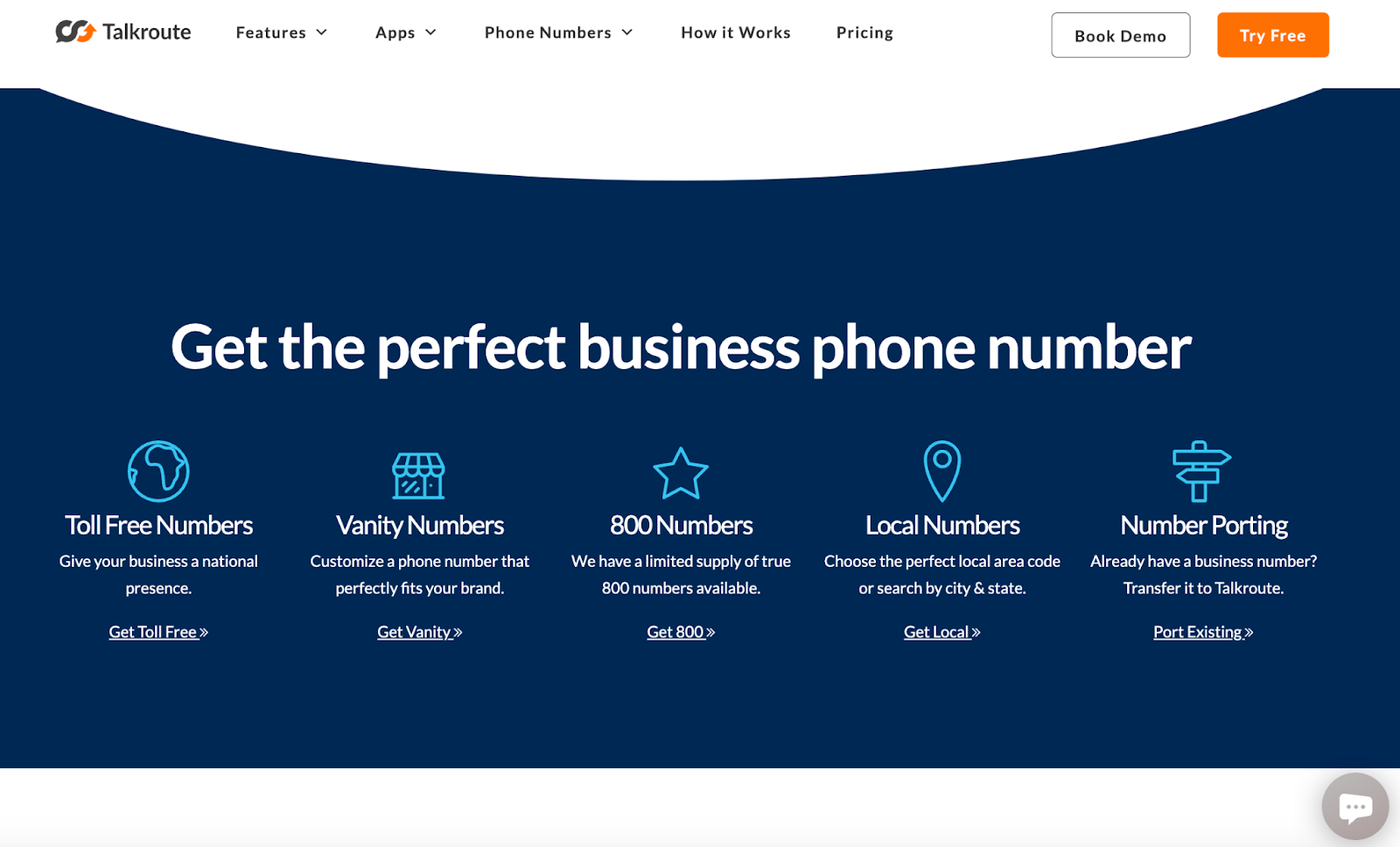
Talkroute gives your business the tools to sound professional without making things complicated. You don’t need to buy extra phones or hire an IT team to get started.
Everything works through your computer or smartphone. You can make and receive calls, send business texts, hold video meetings, and manage your voicemails, all in one place.
One of the best parts is how flexible it is. You can set custom call menus, create extensions for team members, and route calls wherever they need to go.
If you’re working from home, in the office, or on the road, Talkroute helps you stay connected. It also gives your team control with user permissions, voicemail access, and real-time call routing that fits your schedule.
Whether you’re a solo business owner or part of a growing team, Talkroute makes it easy to manage your business communication without stress. It’s designed for people who want a strong, reliable phone system that’s easy to use and doesn’t get in the way.
Experience modern business calling with no strings attached. Sign up and get 7 days free!
FAQs About Virtual Phone Systems Comparison
What is the best virtual phone number service?
If you’re looking for the best and most affordable virtual phone system, Talkroute is a strong choice. It offers a full virtual phone system with unlimited calling, call recording, smart call routing, voicemail transcription, and mobile and desktop apps, all at a fair per-user price.
Small businesses get big features like call forwarding, team messaging, and auto attendants without needing desk phones or a complicated setup.
Can I just plug in a VoIP phone?
You can use VoIP phones, but with Talkroute, you don’t need to. Their business phone service works through desktop and mobile apps, so you can make and receive calls from a cell phone or computer. It’s much easier for small business owners who don’t want to deal with IP phones or extra hardware.
Which virtual number is the best?
The best virtual phone numbers come from services that give you more than just a number. Talkroute gives you toll-free numbers, local phone numbers, and advanced features like smart call routing, voicemail transcription, inbound and outbound calls, and video conferencing.
It’s a great phone system for small businesses that want more than what services like Google Voice or Zoom Phone offer.
What is the difference between a VoIP and a digital phone?
A VoIP phone system uses the Internet Protocol to send voice and video calling, so you can use a mobile device or computer instead of traditional phone lines. A digital phone usually needs special hardware and is less flexible.
VoIP services like Talkroute are better for small businesses because they work with mobile phones, offer team chat, video meetings, and work well with tools like Google Workspace.

Stephanie
Stephanie is the Marketing Director at Talkroute and has been featured in Forbes, Inc, and Entrepreneur as a leading authority on business and telecommunications.
Stephanie is also the chief editor and contributing author for the Talkroute blog helping more than 200k entrepreneurs to start, run, and grow their businesses.




